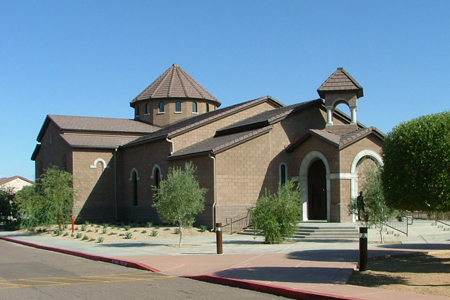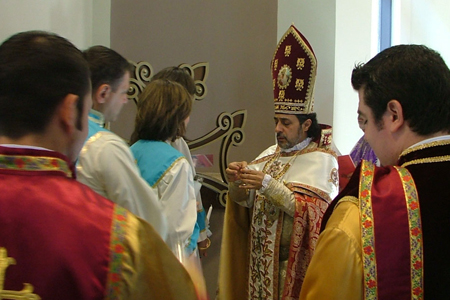| |
 |
 |
 |
| Comment on this report, or find other reports. |
 |
| Our Mystery Worshippers are volunteers who warm church pews for us around the world. If you'd like to become a Mystery Worshipper, start here. |
 |
| Find out how to reproduce this report in your church magazine or website. |
|
|
| 1785: St Apkar,
Scottsdale, Arizona, USA |
 |
 |
 |
Mystery Worshipper:
Amanda B. Reckondwythe, accompanied by Pigwidgeon, Sir Kevin,
Zeke, and Spiffy.
The church:
St Apkar,
Scottsdale, Arizona, USA.
Denomination:
Armenian Apostolic Church, Western
Diocese.
The building:
Fundraising for the present building began in 2003, and ground
was broken in 2008. The event which is the subject of this report
marks the consecration of the newly finished church. The building
was architecturally inspired by the historic 7th century St
Hripsime Church in Armenia. It is constructed of concrete blocks
and is cruciform in shape, with a dome over the crossing. One
enters via a porch with archways; the arch motif is taken up
by the church’s plain glass windows. The interior is not quite
finished – there is no carpeting on the concrete floor and no
wall decorations. The altar sits on a raised stage and was flanked
by vases of flowers. At the back of the altar is an icon of
a rather chubby Madonna and Child. There was no altar curtain,
although everything I have read about the Armenian liturgy states
that certain parts take place behind a closed curtain.
The church: The legend of St Apkar is a fascinating one. Apkar was king of the city of Edessa, in Mesopotamia, during the first century AD. He suffered from an incurable illness but had heard of the miracles wrought by one Jesus of Nazareth. And so Apkar wrote to Jesus begging his help. Jesus is said to have replied in a letter (declared apocryphal by the Western Church) declining Apkar’s invitation to visit but enclosing a cloth bearing his likeness. There is some dispute over whether the cloth was one that Jesus had pressed to his face, or whether it was a painted portrait. After Jesus’ death, resurrection and ascension, the apostle Thaddeus visited Apkar and baptized him, at which time his illness was miraculously cured. The cloth, called the mandylion, survived into the 18th century, finding its way first to Constantinople and later to France, where it disappeared during the French Revolution. The Central Bank of Armenia recently issued a 100,000-dram (US$264) note bearing St Apkar’s image.
The neighborhood:
The church is located on East Cholla Street in the well-to-do
Scottsdale suburb of Phoenix, in a quiet residential section
just east of the expressway known as the Loop 101, which encircles
the Phoenix metropolitan area.
The cast:
His Eminence Archbishop Hovnan Derderian, primate of the Western
Diocese, officiated. He was assisted by the Revd Zacharia Saribekyan,
pastor, and a crowd of deacons, crucifers, flabellum bearers,
acolytes and thurifers. The Divine Liturgy was celebrated in
the presence of His Eminence Archbishop Vatche Hovsepian, former
primate of the Western Diocese. An honored guest was the Revd
Jan Olav Flaaten, executive director of the Arizona Ecumenical
Council.
The date & time: Sunday, September 20, 2009, 10.00am, although the proceedings got underway 15 minutes late.
What was the name of the service?
Consecration of the Church followed by Badarak (Divine Liturgy).
A thorough description of the Badarak can be found here
and here,
the latter with some excellent photos.
How full was the building?
I counted 300 chairs and all were occupied, with people standing in the aisles, in the back and on the porch.
Did anyone welcome you personally?
As I waited outside for the rest of our party to arrive, people smiled and nodded a good morning. Inside, an usher indicated that we should take candles and a handout describing the consecration ceremony.
Was your pew comfortable?
The pews are not yet in – we sat on metal folding chairs with plastic seats. They were comfortable enough and most welcome for the few short minutes that we spent seated.
How would you describe the pre-service
atmosphere?
Lots of excited conversation and visiting. A gentleman played several solo violin pieces with great mastery of his instrument.
What were the exact opening words of the
service?
Almost impossible to say. The procession of crucifer, acolytes, servers and deacons entered in silence until the archbishop arrived at the door, at which time the organ bellowed thunderous tones and the choir broke out in a rich chant. The text was in Armenian but was, I believe, Psalm 26: “Vindicate me, O Lord, for I have led a blameless life; I have trusted in the Lord without wavering.” The archbishop was preceded by two thurifers walking backwards as they swung their censers.
What books did the congregation use during the
service?
Nothing other than a handout describing the consecration ceremony. There was nothing for the Badarak itself.
What musical instruments were played?
Electronic organ, but only to support the chant. A guest choir, the Khachadourian Choir of Los Angeles, provided the music. The absence of carpeting or other acoustical baffling made for a very live acoustics, and the choir and organ benefited greatly from this.

Did anything distract you?
I had quite a time making out the various vestments. The basic pattern was a robe with an embroidered yoke. The church elders (men and women) wore white robes with blue yokes. The choir wore grey robes with highly embroidered red yokes. The servers and deacons wore gold robes with red yokes embroidered with gold crucifixes; the deacons added a stole over their left shoulder. Archbishop Derderian, who could pass as the twin brother of actor Al Pacino, wore a gold cope-like garment embroidered in red, with a red mitre. He carried a gold crosier. Archbishop Hovsepian alone stood out in a white cope with gold embroidery and a black pointed hood – he looked very medieval!
Was the worship stiff-upper-lip, happy clappy, or
what?
The whole thing can best be described as liturgy on steroids. The consecration ceremony was most interesting. The archbishop washed the altar with water and wine and then anointed it with oil. He next anointed the four walls of the church. The handout stated that he would climb the pillars to anoint crosses placed at the top of each – I was eagerly awaiting this, but (lucky for him) the crosses had been placed within easy arm’s reach. Incense was dispensed almost non-stop by the two thurifers. The Badarak itself followed a recognizable Western structure – confession and absolution, praise and instruction, eucharistic celebration, thanksgiving and dismissal – but to a degree and with an intensity that I had never experienced before. The entire service was chanted in Armenian, a recitative between archbishop and choir. The archbishop turned to bless the congregation at least a dozen times, each time accompanied by billows of incense from the two thuribles. If heaven is non-stop liturgy like this, then let me have it!
Exactly how long was the sermon?
15 minutes.
On a scale of 1-10, how good was the preacher?
7 – The archbishop spoke first in Armenian, then in English. His Armenian was lively and spirited, but he read his English from yellow legal sheets. His accent was heavy, and my ability to concentrate on what he was saying was made all the harder by non-stop babbling and gurgling from a little girl sitting behind me.
In a nutshell, what was the sermon
about?
The archbishop took as his text Jeremiah 1:5 (“Before I formed you in the womb I knew you, before you were born I set you apart”). God calls us all to serve in many ways. Our journey toward God begins today. St Paul wrote that we are citizens of God’s country. Today we celebrate the labor of the many who made St Apkar’s Church a reality. The church is a miracle in the life of the community. Today is a new Pentecost in our spiritual life.
Which part of the service was like being in
heaven?
The music was absolutely riveting! The chant was reminiscent of Russian chant with a middle eastern heft to it. The choir consisted of dozens of men with deep Russian-like voices as well as one or two women, whose vocal line soared over the others. We all felt we could have listened to it all day. During his announcements, Archbishop Derderian made a special point of thanking the Revd Flaaten for accepting his invitation to attend on behalf of the ecumenical Christian community of Arizona. He asked Mr Flaaten to extend his love and respect to all the members of the council. Why can’t all ecumenism be like that? I wondered.
And which part was like being in... er... the other place?
The altar party could have used a little more rehearsal. Some of the deacons had frequently to gesture, beckon or otherwise direct the younger acolytes and servers, in one or two cases grabbing them by the shoulders and steering them to where they should be. Granted it was a long and difficult service, and one not celebrated every day, but it seemed to lack the finesse and polish we are used to in the best of our Western churches and cathedrals.
What happened when you hung around after the service looking lost?
As people went up for communion, we noted that ushers were folding up the chairs and carrying them outside. Pigwidgeon opined that perhaps they were due back at the rental place – the service had lasted for almost three hours. As people had no place to sit when they returned from communion, they all left. And that, so far as I know, is how the service ended.
How would you describe the after-service
coffee?
The liturgy was followed by a special luncheon for which we had purchased tickets in advance. We all went over to the parish hall, where we were assigned tables. By the time the welcoming remarks and congratulatory speeches were done, it was almost time for dinner – well, high tea anyway. We were served roast beef accompanied by boiled potatoes, a cheese pastry, cold stewed tomatoes, and a porridge-like dish consisting of chicken fat and barley. Our party occupied most of a table, but we were joined by two young gentlemen who chatted amiably with us.
How would you feel about making this church your regular (where 10 = ecstatic, 0 = terminal)?
8 – It was a very long service – I couldn’t take it every week. But it was beautiful. The people seemed to be a friendly and accessible crowd. I did not at all experience the feeling of isolation I often feel when attending Orthodox services.
Did the service make you feel glad to be a
Christian?
Oh, my goodness, yes!
What one thing will you remember about all this in seven days' time?
The beautiful music. |
|
|
 |
 |
 |
| We rely on voluntary donations to stay online. If you're a regular visitor to Ship of Fools, please consider supporting us. |
 |
 |
 |
| The Mystery Pilgrim |
 |
| One of our most seasoned reporters makes the Camino pilgrimage to Santiago de Compostela in Spain. Read here. |
 |
 |
 |
| London churches |
 |
| Read reports from 70 London churches, visited by a small army of Mystery Worshippers on one single Sunday. Read here. |
| |
|
|
|
|


